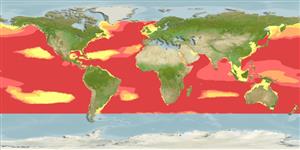Common names from other countries
Environment: milieu / climate zone / depth range / distribution range
Ecología
marino batipelágico; rango de profundidad 2 - 4992 m (Ref. 50610), usually 500 - 2000 m. Deep-water; 65°N - 46°S, 180°W - 180°E
Worldwide in tropical to temperate seas. In the western Atlantic it is also known from the Flemish Cap (Ref. 5951).
Length at first maturity / Tamaño / Peso / Age
Maturity: Lm ?, range 13 - ? cm
Max length : 18.0 cm TL macho / no sexado; (Ref. 5951)
Espinas dorsales (total): 0; Radios blandos dorsales (total): 17-20; Espinas anales 0; Radios blandos anales: 7 - 9; Vértebra: 28. Body uniformly blackish or dark blackish brown (Ref. 27363). Lateral line an open groove, bridged by scales at intervals. Swim bladder present. Juveniles: long cephalic and preopercular spine; big eye; teeth on jaws small, multiserial on premaxilaries; no teeth on palatine and vomer; gill rakers long and slender. Adult: no cephalic and preopercular spines; eye small; gill rakers tooth-like in groups on bony bases.
Bathypelagic (Ref. 58426). Adults occur mainly between 500 and 2,000 m, but ranging from near the surface (young) to 5,000 m. Form schools, swim in small groups or solitary. Carnivorous (Ref. 27155), feeding on crustaceans when young and on fish mainly when adults (Ref. 4737). Serve as food for pelagic fishes such as tuna, albacore, and marlin (Ref. 5951). Oviparous, with planktonic larvae (Ref. 36624).
Life cycle and mating behavior
Madurez | Reproducción | Puesta | Huevos | Fecundidad | Larva
Post, A., 1986. Anoplogasteridae. p. 767-768. In P.J.P. Whitehead, M.-L. Bauchot, J.-C. Hureau, J. Nielsen and E. Tortonese (eds.) Fishes of the north-eastern Atlantic and the Mediterranean. UNESCO, Paris. Vol. 2. (Ref. 4737)
IUCN Red List Status (Ref. 130435)
CITES (Ref. 128078)
Not Evaluated
Threat to humans
Harmless
Human uses
Warning: mysqli::__construct(): (HY000/1040): Too many connections in /var/www/html/includes/func_getlabel.php on line 46
Can't connect to MySQL database (fbapp). Errorcode: Too many connections
